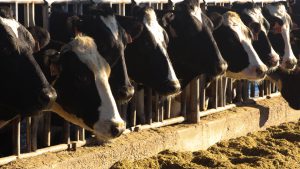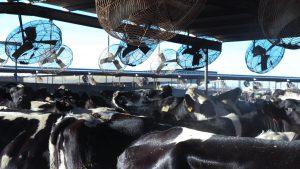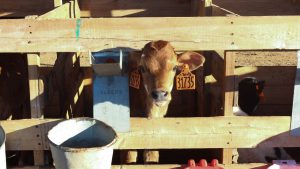- Slug: BC-CNS-Dairy Industry,900
- Photos available (thumbnail, caption below)
By CHARLIE CLARK
Cronkite News
MESA – Jim Boyle’s family history is intertwined with Arizona dairy. His grandfather had 50 cows. His dad had 500. And now the Boyle family has 6,000 at three dairies.
Boyle said the family business grew organically along with Phoenix’s population, and they now have two dairies in Mesa and one in Casa Grande. His business mirrors the growth of others in Arizona.
“Everyone has expanded to keep up with demand,” he said. “And Arizona – outside of the summer months – is really good environment for dairy cows.”
Arizona may be more known for its cattle, citrus and vegetables, but dairies and dairy farmers produce the state’s No. 1 commodity with nearly 200,000 cows producing more than $750 million worth of milk, according to the Arizona Department of Agriculture’s fiscal 2016 report.
The dairy industry has recently made headlines because of a nationwide class-action lawsuit and settlement.
Arizona residents who bought dairy products any time since 2003 have until the end of the day Tuesday to file a claim for a cash settlement.
Although the exact amount will depend on how many people apply, it could bring each Arizona applicant $40 to $70.
The lawsuit was filed against the National Milk Producers Federation in 2011. It involved 15 states.
The suit alleged that members of the federation engaged in a massive price-fixing scheme during the economic downturn. It involved dairy cooperatives paying farmers above market prices to prematurely retire hundreds of thousands of cows and send them to slaughter.
During the Great Recession, milk producers faced some of the lowest milk prices since 1970, according to the United Dairymen of Arizona. Here in Arizona, dairy farmers were losing about $1 per cow, per day, and the average Arizona herd ranges upwards of 2,000 cows.
So Cooperatives Working Together, a program developed by National Milk Producers, offered to buy cows to pay farmers extra for sending cows to beef and for some, Boyle said that money made enough sense for them to get out.
“Our farmers had to make tough decisions on whether to tough it out and stay in business or to shut down their dairy at the risk of losing more money,” according to a statement by the United Dairymen of Arizona.
Ultimately, the federation settled for $52 million without making an admission of wrongdoing.
United Dairymen of Arizona, the state’s large dairy cooperative consisting of more than 90 Arizona farms, is part of the National Milk Producers Federation.
Products exporter and job creator
High temperatures and a lack of rain make it easy to forget that agriculture in Arizona is massive. For fiscal 2016, agriculture’s impact on the Arizona economy was about $17.1 billion and more than 77,000 jobs, according to the agriculture department.
But when it comes to dairy farming in particular, the industry is sometimes overlooked.
“Most people don’t realize just how big this industry is and what it means to our state,” Arizona Department of Agriculture Director Mark Kilian said.
Kilian added that the dairy industry supports thousands of jobs throughout the state and is a significant exporter as well, typically exporting dairy products in the forms of cheese or powders.
Additionally, Arizona dairy promotes jobs in other agriculture sectors because of the feed requirements of the herds.
Thriving in the heat
In the past 20 years, Kilian said dairy has grown dramatically with the advancements in technology, and Arizona has drawn dairy farmers from other states.
He said that high-quality alfalfa and Saudi Arabian-style dairy barns – which often utilize misters and fans in open-sided barns to keep cows cool, according to CNN – has contributed to high milk production in cows and made Arizona an attractive farming space.
Arizona’s proximity to California and Mexico is also a plus.
With the ability to easily export to other major markets, a growing local population, a kinder regulatory market and lower labor costs, Arizona provides a good alternative for milk producers and processing plants that might otherwise go to California, Boyle said.
Farming in the heat is not the only thing that sets Arizona dairy apart.
While Arizona farmers may not have as many cows compared to California or Wisconsin, herd sizes here are much bigger, said Bob Collier, a University of Arizona professor and expert in the field of dairy sciences.
In fact, the average herd in Arizona is between 2,500 and 3,000 cows. In the upper Midwest, Collier said it is probably between 250 to 500 cows.
Collier said the larger facilities can help reduce overhead.
Challenges facing industry
Although responsible for bolstering the dairy industry, Arizona’s continued growth is somewhat of a double-edged sword.
Urban growth and expansion in the Valley means there is less available farmland, but Boyle said many dairies have been able to stay ahead of development and move south.
But there is only so much farmland. The farther away you get from the major cities, the farther away you get from milk processing plants and the consumer population and the more you increase the expense of your haul.
In the long term, Boyle said the industry also will face challenges with the availability of water, and farmers will need to find the balance between water and feed availability.
The proximity of dairies to cities brings environmental issues as well, and cash receipts for dairy products in 2016 have declined.
Despite those factors, Collier said he has an optimistic outlook.
“It is a very healthy and vibrant industry. I think it is going to do well,” Collier said. “It is in a very good position to grow slowly with demand, but still to grow.”
^__=


